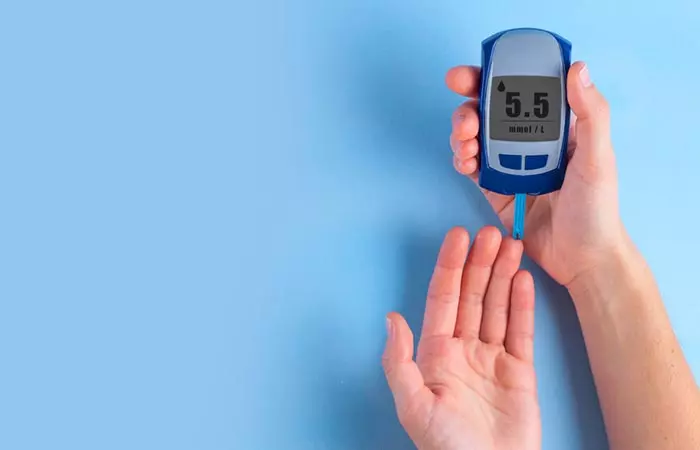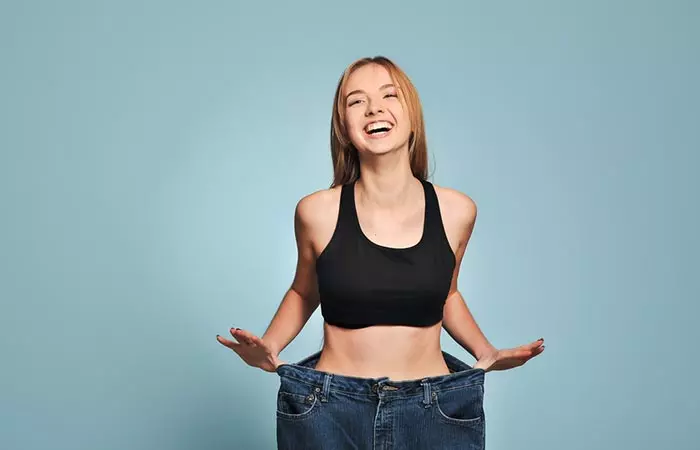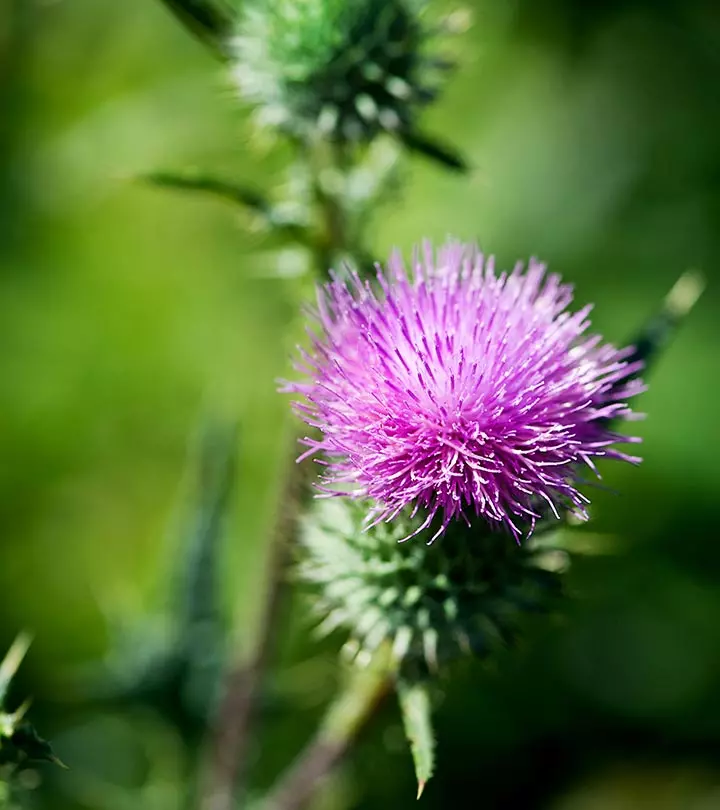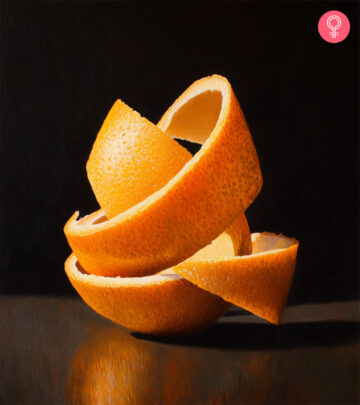14 Health Benefits Of Wheatgrass, Nutrition, & Side Effects
Enliven your smoothies with a dash of this superfood to enhance your general health.

Image: iStock
Many benefits of wheatgrass may sway you toward adding it to your diet. Wheatgrass is the young leaves of the wheat plant and is often referred to as green blood. It has a powerful nutritional profile and is classified as a superfood.

There are many ways to consume wheatgrass – powder, capsules, pills, juice, and more. It is an excellent general health tonic and has antibacterial, anti-inflammatory, antioxidant, and neuroprotective propertiesi The ability of a substance to protect the nerve cells from damage and prevent anything that may impair their functions. . Wheatgrass can lower cholesterol levels, reduce cancer risk, manage diabetes, reduce inflammation, and help with weight loss.
This article discusses the benefits of wheatgrass, its recommended dosage, how to include it in your diet, and its potential risks. Keep reading.
 Know Your Ingredient: Wheatgrass
Know Your Ingredient: WheatgrassWhat Is It?
A young wheat plant that is harvested before maturity and is commonly used in drinks and food.
What Are Its Benefits?
It helps control cholesterol levels, aids in weight loss, and boosts energy levels.
Who Can Consume It?
Anyone can consume it except people with celiac disease or gluten intolerance.
How Often?
You can consume 1 to 2 ounces of wheatgrass daily.
Caution
Avoid consuming wheatgrass if you are pregnant or breastfeeding. Excessive consumption may cause headaches, nausea, and vomiting.
In This Article
Benefits Of Wheatgrass
Wheatgrass offers numerous health benefits from aiding weight loss to reducing cholesterol levels and inflammation. What’s more? They are all scientifically backed! Scroll down to learn more about the benefits of adding wheatgrass to your daily diet.
1. May Reduce Cholesterol Levels

Some studies have found that wheatgrass may reduce cholesterol levels in the body. In animal studies, rabbits with high cholesterol levels were given a wheatgrass diet. The antioxidant effect of wheatgrass could help reduce their cholesterol levels, thereby improving cardiovascular health (1).
Another study done on rats found that fresh wheatgrass juice could show a hypolipidemic effect (cholesterol-reducing) (2).
However, more studies are needed in this regard.
2. May Minimize Risk Of Cancer
Wheatgrass is said to possess anticancer properties that may help fight against cancer cells (3). Cancer cells thrive in a low oxygen environment. Wheatgrass supplies high oxygen to all the body tissues, and this may help in combating cancer (4).
Wheatgrass was also found to exhibit cytotoxici The ability of a certain medication or compound to damage living cells, including cancer cells, to prevent their spread. and anti-proliferationi The ability of a compound to inhibit the spread of malignant cells beyond the affected tissue. activities (5). Another study conducted on 60 patients with breast cancer found that wheatgrass juice could help reduce the risk of blood toxicity due to chemotherapy (6). However, more studies in this line are needed to reach further conclusions and to know how it helps in cancer prevention.
3. May Help Treat Diabetes

Wheatgrass may help control blood sugar levels. A study on type 2 diabetes rats found that the glucose oxidative enzymes in wheatgrass could help decrease blood glucose levels (7).
In another study, treating diabetic rats with ethanolic extracts of wheatgrass for 30 days resulted in reduced levels of blood glucose levels (8).
However, more studies are required to understand this benefit of wheatgrass in humans.
4. May Alleviate Inflammation
Wheatgrass may help alleviate chronic inflammation. A study found that wheatgrass juice may help treat inflammatory gastrointestinal conditions (9).
Wheatgrass is rich in chlorophyll. Research shows that chlorophyll possesses anti-inflammatory properties (10). Another study found that chlorophyll-related compounds may inhibit inflammation in human aortic cells (11).
5. May Aid Weight Loss

Consumption of wheatgrass may promote weight loss due to the presence of thylakoids. A study conducted on rodents found that thylakoids can slow down gastric emptying. Adding them to a high carbohydrate meal can also suppress hunger. These factors may help reduce body weight (12).
Another study also states that thylakoids suppress appetite by increasing levels of cholecystokinin (a hormone that stimulates the release of bile). This could result in lower food intake (13).
Thylakoids also affect other appetite hormones like ghrelin, which may increase the feeling of fullness (14).
 Did You Know?
Did You Know?6. May Improve Digestive Health
Intake of wheatgrass may improve digestive health. Wheatgrass contains many digestive enzymes that promote digestion (15). The juice also increases bowel movements (16).
Some anecdotal evidence suggests that wheatgrass may clean intestines and also reduce issues like bloating, gas, and abdominal discomfort. However, more studies in this line are needed to support this claim.
7. May Boost Metabolism
Wheatgrass intake may help boost metabolism and body weight (3). Some anecdotal evidence suggests that wheatgrass powder may help control body weight by stimulating the thyroid gland. This may improve metabolism and prevent indigestion. However, very limited research is available to support this claim.
8. May Improve Immunity
Studies suggest that wheatgrass may improve immune health. It helps increase the red blood cell (RBC) and white blood cell (WBC) counts. It also has antiviral and anti-inflammatory properties that may help boost immunity (8).
However, more studies in this line are needed to reach further conclusions.
9. May Lower Blood Pressure

Some anecdotal evidence suggests that wheatgrass may lower blood pressure. The chlorophyll in wheatgrass may increase blood cell production. This may help regulate blood pressure. However, limited research is available to support this point.
10. May Improve Cognitive Function
The neuroprotective effects of wheatgrass may promote cognitive functioni It refers to mental abilities and complex brain processes, including learning, memory, and reading. in individuals with chronic fatigue syndrome (17).
A study conducted by the Daegu Haany University, Korea, found that wheatgrass may help prevent memory impairment and boosts brain function (18).
11. May Treat Arthritis
Wheatgrass may treat rheumatoid arthritis (3), (8). The anti-inflammatory properties of wheatgrass may play a role in this regard (17).
However, more research is needed to reach further conclusions.
12. May Boost Energy Levels
The proteins in wheatgrass may prevent disease and improve the process of energy-related mechanisms in the body (19).
A weakened immune system makes you feel tired. The chlorophyll content in wheatgrass has antibacterial properties that may fight against many infections. This could boost your immune system and potentially promote energy levels. However, there is no direct research to prove this claim yet.
 Trivia
Trivia13. May Treat Kidney Issues
Research is limited in this area. Some anecdotal evidence suggests that intake of wheatgrass powder may help fight against kidney problems.
Consuming wheatgrass powder regularly has shown to relieve the subsequent symptoms of kidney cysts (like severe back pain and abdominal pain). Wheatgrass also may help slow down the growth rate of cysts.
14. May Improve Skin Health
The vitamin A in wheatgrass enhances skin luster and offers a natural glow. In rat studies, wheatgrass could treat atopic dermatitis-like skin lesions (20).
Drinking wheatgrass juice may help fight skin issues like psoriasis and eczema. However, limited research is available in this regard.
In addition, wheatgrass has been touted as a natural remedy for detoxification. Many anecdotal evidence suggests that wheatgrass may help in stress reduction. However, limited data is available to prove this claim.
Leaj Kirchinger, a vlogger, shared how consuming wheatgrass juice positively impacted her overall health. She said, “I have noticed an increase in energy about 20 minutes after drinking just a little bit of the wheatgrass juice (i).”
These are the benefits of wheatgrass. In the following section, we have extensively covered its nutritional profile.
Key Takeaways
- Wheatgrass is rich in neuroprotective, antioxidant, and anti-inflammatory properties.
- It may increase energy levels and improve metabolism rate.
- Wheatgrass may lower cholesterol, helps in blood sugar control, and aid in weight loss.
- In some individuals, wheatgrass may cause headaches, nausea, or allergies.
- Consume wheatgrass juice in less quantity and mixed with other vegetable juices as it is concentrated.
What Is The Nutritional Value Of Wheatgrass?
Wheatgrass is an excellent source of several vitamins and minerals. According to the United States Department of Agriculture, 100 g of wheatgrass powder consists of (21):
- Energy – 312 kcal
- Protein – 12.5 g
- Carbohydrate – 75 g
- Total Dietary Fiber – 50 g
- Calcium – 300 mg
- Iron – 12.5 mg
Wheatgrass is a good source of vital nutrition and contains protein, antioxidants, bioflavonoidsi A group of plant nutrients found in citrus fruits, possessing antioxidant and medicinal properties. , and amino acids. Wheatgrass consists of 17 different amino acids, and 8 of those are essential to humans (our body cannot produce them) (22). It also contains a type of green pigment, known as chlorophyll, which has many health benefits (23).
Also, wheatgrass possesses antioxidant properties that may help reduce oxidative damage to cells (24). In addition, it has higher alkalinity than most fruits and vegetables.
Though wheatgrass is generally safe for consumption, it does have a few side effects that you need to keep in mind. Check them out in the following section.
What Are The Side Effects Of Wheatgrass?

Though it is usually considered safe, there have been cases of side effects of wheatgrass following its consumption. Since it is grown within the soil and consumed raw, wheatgrass also has an increased risk of contamination. The common adverse effects of wheatgrass include headache, nausea, and allergies.
1. May Cause Headache
Excess intake of wheatgrass juice may lead to headache (25). Hypersensitive individuals may experience throat swelling too (26). Some believe the headache could also be a sign of your body’s general intolerance to the juice.
Taking the juice in lesser quantities could reduce the risk of headaches. The methanol extract of the juice was found to be safe at a dose level of 2000 mg per kg of body weight (27).
Wheatgrass contamination is said to be often caused by an organism called Listeria monocytogenes. This organism can cause serious side effects, and one of them is a severe headache (28).
2. May Cause Nausea
Some believe wheatgrass contains gluten. It could cause adverse symptoms, including nausea, in people who are gluten-intolerant (29). However, a research paper concludes that wheatgrass contains no gluten (30). Hence, more research is required to understand this particular side effect of wheatgrass.
3. May Cause Allergies
Some individuals could be allergic to wheatgrass, especially when they consume it in a pill or juice form. If you are allergic to wheat products, it is recommended you stay away from wheatgrass as well (31).
The symptoms of wheatgrass allergy are yet to be studied. As per anecdotal evidence, an allergy may cause nausea, cramping, vomiting, and diarrhea. Your skin may get inflamed and break out into hives. Other allergic reactions may include shortness of breath and congestion. So, if you have never had wheatgrass before and wish to try it, consider having a small amount to gauge your body’s reaction to it. In case you experience any of the symptoms mentioned above, visit your doctor immediately.
As previously discussed, wheatgrass does not contain gluten. This is because it is made out of the stem and leaves, whereas gluten is found in the kernel of the seed. But if one of the seeds is accidentally included, it could get contaminated with gluten. Hence, individuals with gluten intolerance are recommended to exercise caution while taking wheatgrass. Read the ingredient labels before purchasing any product.
Some benefits of wheatgrass are yet to be studied. However, you may go ahead and include wheatgrass in your diet. But before you do so, it is important to take some precautions.
Precautions To Be Taken
- Wheatgrass juice is usually concentrated. Hence, take it in less quantities or in combination with other vegetable juices (to mask its strong taste).
- If your wheatgrass juice tastes bitter, it is most likely to be moldy. Stop drinking and discard it immediately.
- To avoid contamination, you can sterilize the trays in which wheatgrass grows (if you are growing it at your home).
- Store your wheatgrass powder supplement as per the instructions on the pack.
Tips For Use And Consumption
You can enhance the taste of wheatgrass by adding other flavoring agents. Wheatgrass is available in different forms like powder, smoothie or juice, and pills. Generally, adding an ingredient that has a strong taste may make it more palatable.
You can add honey, milk, or any fruit juice to raw wheatgrass for better taste. You may also blend fresh wheatgrass into homemade smoothies, salad dressings, clear-broth soups, and sauces. You can also blend and add it to your baking dough for a nutritional boost.
Of all the forms, the capsule form of wheatgrass is less grassy in taste. However, flavored capsules are also available in the market.
Wheatgrass products are available at health food stores. You can purchase them online too!
You can also prepare your own wheatgrass juice right in the comfort of your home.
How Do You Make Wheatgrass Juice?
is most beneficial after juicing. While it can be made in larger quantities and refrigerated or frozen, it is optimal to juice it in single batches. Try having it daily to reap its wonderful benefits.
- Wash approximately ¼ cup of wheatgrass per single shot of juice.
- Roughly chop the grass into smaller pieces.
- Measure the grass to ensure ¼ cup of grass per serving.
- Add honey or any other fruit juice for taste.
How Do You Make Wheatgrass Powder?
Making wheatgrass powder at home is simple. Follow the below procedure:
- Harvest/cut wheatgrass by trimming it at 1/2 an inch above the soil.
- Place your wheatgrass on a baking sheet to dry it out at 120o -150o F for about an hour. It must feel dry/brittle to the touch.
- Grind your dry wheatgrass in a coffee grinder until it turns to powder.
- Store your wheatgrass powder in the container(s) of your choice.
You also can use wheatgrass to make delicious and nutritious recipes. Check out one such recipe in the next section.
A Delicious Wheatgrass Recipe
Wheatgrass Raspberry Smoothie

What You Need
- 1 or 2 ounces of wheatgrass
- 1 or 2 ounces of spinach
- ½ avocado, without pit
- 2 teaspoons of lemon juice
- ½ apple with seeds
- 125 g of fresh raspberries
- ½ mango, without seed
- 2 ripe, peeled bananas
- 2 glasses of water
How To Prepare
- Halve the avocado and scoop out the flesh into a blender. Peel half a mango and add it to the blender along with the apples, wheatgrass, spinach, lemon juice, and some water.
- Blend at high speed until the mixture is green and smooth. Transfer the mixture to a bottle. Keep it aside.
- Add raspberries, peeled bananas, and water to the blender.
- Blend on high speed for a minute.
- Layer the smoothie in a glass starting with the pink raspberry banana blend.
- Follow it with the wheatgrass smoothie.
- Repeat the layering process and serve.
Infographic: Top 6 Ways Wheatgrass Can Benefit You
Wheatgrass, also known as green blood, has gained popularity due to its innumerable health benefits. Whether you have already incorporated this potent ingredient in your daily routine or are planning to try it, the top 6 benefits mentioned below will further convince you to give this superfood a chance. Go ahead and check out the infographic below!
Some thing wrong with infographic shortcode. please verify shortcode syntaxWheatgrass benefits are numerous. It is loaded with protein, amino acids, bioflavonoids, and antioxidants. It lowers cholesterol levels, reduces cancer risk, helps treat diabetes and arthritis, improves digestive health and cognitive function, aids in weight loss, and boosts immunity and metabolism. It also improves skin health and boosts energy levels. However, wheatgrass may cause a few reported side effects like headaches, nausea, and allergies. Hence, caution is advised. Avoid taking wheatgrass juice if it tastes bitter. You can take it in moderate amounts with other vegetable juices to reap the mentioned benefits.
Frequently Asked Questions
What is the best time to take wheatgrass?
We recommend you to take wheatgrass on an empty stomach as it will be easily absorbed into the blood (in 20 minutes). Though certain sources say this is the only way to take it, there is no proper evidence. Consult your doctor.
Can wheatgrass reverse gray hair?
Anecdotal evidence suggests that intake of wheatgrass on a daily basis may reverse gray hair. However, there is no evidence to prove this claim.
Can wheatgrass replace vegetables?
No, wheatgrass cannot replace vegetables. It may not contain some nutrients present in other veggies.
Does wheatgrass clean the liver?
Wheatgrass protects the liver against stress induced by alcohol consumption, and other toxins (32). It is considered to have a detoxifying effect on the liver and also helps in improving liver health.
How much wheatgrass powder should you take per day?
Follow the recommended dosage on the packaging label, or as prescribed by your healthcare provider. The usual dose is 1 teaspoon or about 3–5 gms of powder per day.
Can I drink wheatgrass powder with water?
Yes, you can blend it with water and drink it.
How do you use wheatgrass powder in milk?
You can blend it with milk and drink it. To make it a more interesting drink, you can also add bananas and/or other fruits of your choice and make a smoothie.
Does wheatgrass have vitamin D?
No, there is no evidence to suggest that wheatgrass contains vitamin D.
Is wheatgrass a blood thinner?
A study suggests that wheatgrass may reduce clotting time and bleeding in some cases. However, more research is required to establish its efficacy as a blood thinner (33).
Illustration: Health Benefits Of Wheatgrass, Nutrition, & Side Effects

Image: Stable Diffusion/StyleCraze Design Team
Learn about the benefits of wheatgrass from a certified dietitian in this informative video. Discover how wheatgrass can improve your health and well-being.
Personal Experience: Source
StyleCraze's articles are interwoven with authentic personal narratives that provide depth and resonance to our content. Below are the sources of the personal accounts referenced in this article.
i. Wheat grass juice!: Personal benefits | Life- Changing!https://www.youtube.com/watch?v=WdUxcE2xWOY
References
Articles on StyleCraze are backed by verified information from peer-reviewed and academic research papers, reputed organizations, research institutions, and medical associations to ensure accuracy and relevance. Read our editorial policy to learn more.
- Sethi J, Yadav M, Dahiya K, Sood S, Singh V, Bhattacharya SB. Antioxidant effect of Triticum aestivium (wheat grass) in high-fat diet-induced oxidative stress in rabbits. Methods Find Exp Clin Pharmacol. 2010;32(4):233–235.
https://pubmed.ncbi.nlm.nih.gov/20508870/ - Kothari S, Jain AK, Mehta SC, Tonpay SD. Hypolipidemic effect of fresh Triticum aestivum (wheat) grass juice in hypercholesterolemic rats. Acta Pol Pharm. 2011;68(2):291–294.
https://pubmed.ncbi.nlm.nih.gov/21485304/ - Bar-Sela G, Cohen M, Ben-Arye E, Epelbaum R. The Medical Use of Wheatgrass: Review of the Gap Between Basic and Clinical Applications. Mini Rev Med Chem. 2015;15(12):1002–1010.
https://pubmed.ncbi.nlm.nih.gov/26156538/ - Gore, Rucha Diwakar et al. “Wheatgrass: Green Blood can Help to Fight Cancer.” Journal of clinical and diagnostic research : JCDR vol. 11,6 (2017): ZC40-ZC42.
https://www.ncbi.nlm.nih.gov/pmc/articles/PMC5534514/ - Alitheen NB, Oon CL, Keong YS, Chuan TK, Li HK, Yong HW. Cytotoxic effects of commercial wheatgrass and fiber towards human acute promyelocytic leukemia cells (HL60). Pak J Pharm Sci. 2011;24(3):243–250.
https://pubmed.ncbi.nlm.nih.gov/21715255/ - Bar-Sela G, Tsalic M, Fried G, Goldberg H. Wheat grass juice may improve hematological toxicity related to chemotherapy in breast cancer patients: a pilot study. Nutr Cancer. 2007;58(1):43–48.
https://pubmed.ncbi.nlm.nih.gov/17571966/ - Shakya G, Randhi PK, Pajaniradje S, Mohankumar K, Rajagopalan R. Hypoglycaemic role of wheatgrass and its effect on carbohydrate metabolic enzymes in type II diabetic rats. Toxicol Ind Health. 2016;32(6):1026–1032.
https://pubmed.ncbi.nlm.nih.gov/25116122/ - Mohan, Yogesha et al. “Antidiabetic and Antioxidant Properties of Triticum aestivum in Streptozotocin-Induced Diabetic Rats.” Advances in pharmacological sciences vol. 2013 (2013): 716073.
https://www.ncbi.nlm.nih.gov/pmc/articles/PMC3876669/ - Ben-Arye E, Goldin E, Wengrower D, Stamper A, Kohn R, Berry E. Wheat grass juice in the treatment of active distal ulcerative colitis: a randomized double-blind placebo-controlled trial. Scand J Gastroenterol. 2002;37(4):444–449.
https://pubmed.ncbi.nlm.nih.gov/11989836/ - Subramoniam A, Asha VV, Nair SA, et al. Chlorophyll revisited: anti-inflammatory activities of chlorophyll a and inhibition of expression of TNF-α gene by the same. Inflammation. 2012;35(3):959–966.
https://pubmed.ncbi.nlm.nih.gov/22038065/ - Lin KH, Hsu CY, Huang YP, et al. Chlorophyll-related compounds inhibit cell adhesion and inflammation in human aortic cells. J Med Food. 2013;16(10):886–898.
https://pubmed.ncbi.nlm.nih.gov/24066944/ - Stenblom EL, Montelius C, Östbring K, et al. Supplementation by thylakoids to a high carbohydrate meal decreases feelings of hunger, elevates CCK levels and prevents postprandial hypoglycaemia in overweight women. Appetite. 2013;68:118–123.
https://pubmed.ncbi.nlm.nih.gov/23632035/ - Köhnke R, Lindqvist A, Göransson N, et al. Thylakoids suppress appetite by increasing cholecystokinin resulting in lower food intake and body weight in high-fat fed mice. Phytother Res. 2009;23(12):1778–1783.
https://pubmed.ncbi.nlm.nih.gov/19548286/ - Stenblom, Eva-Lena et al. “Dietary green-plant thylakoids decrease gastric emptying and gut transit, promote changes in the gut microbial flora, but does not cause steatorrhea.” Nutrition & metabolism vol. 13 67. 12 Oct. 2016.
https://www.ncbi.nlm.nih.gov/pmc/articles/PMC5059972/ - Tsai, Chia-Che et al. “The immunologically active oligosaccharides isolated from wheatgrass modulate monocytes via Toll-like receptor-2 signaling.” The Journal of biological chemistry vol. 288,24 (2013): 17689-97.
https://www.ncbi.nlm.nih.gov/pmc/articles/PMC3682569/ - Wan, Ping et al. “Advances in treatment of ulcerative colitis with herbs: from bench to bedside.” World journal of gastroenterology vol. 20,39 (2014): 14099-104.
https://www.ncbi.nlm.nih.gov/pmc/articles/PMC4202341/ - Borah, Mukundam et al. “A Study of the Protective Effect of Triticum aestivum L. in an Experimental Animal Model of Chronic Fatigue Syndrome.” Pharmacognosy research vol. 6,4 (2014): 285-91.
https://www.ncbi.nlm.nih.gov/pmc/articles/PMC4166815/ - Jang JH, Kim CY, Lim SH, et al. Neuroprotective effects of Triticum aestivum L. against beta-amyloid-induced cell death and memory impairments. Phytother Res. 2010;24(1):76–84.
https://pubmed.ncbi.nlm.nih.gov/19441012/ - Parit SB, Dawkar VV, Tanpure RS, Pai SR, Chougale AD. Nutritional Quality and Antioxidant Activity of Wheatgrass (Triticum aestivum) Unwrap by Proteome Profiling and DPPH and FRAP assays. J Food Sci. 2018;83(8):2127–2139.
https://pubmed.ncbi.nlm.nih.gov/30059150/ - Mujoriya, Rajesh, and Ramesh Babu Bodla. “A study on wheat grass and its Nutritional value.” Food Science and Quality Management 2 (2011): 1-8.
https://www.researchgate.net/publication/279370893_A_study_on_wheat_grass_and_its_Nutritional_value - “FoodData Central Search Results.” FoodData Central,
https://fdc.nal.usda.gov/fdc-app.html#/food-details/601871/nutrients - Khan, Masood Shah et al. “Chromatographic analysis of wheatgrass extracts.” Journal of pharmacy & bioallied sciences vol. 7,4 (2015): 267-71.
https://www.ncbi.nlm.nih.gov/pmc/articles/PMC4678994/ - Wangcharoen W, Phimphilai S. Chlorophyll and total phenolic contents, antioxidant activities and consumer acceptance test of processed grass drinks. J Food Sci Technol. 2016;53(12):4135–4140.
https://pubmed.ncbi.nlm.nih.gov/28115753/ - Kulkarni SD, Tilak JC, Acharya R, Rajurkar NS, Devasagayam TP, Reddy AV. Evaluation of the antioxidant activity of wheatgrass (Triticum aestivum L.) as a function of growth under different conditions. Phytother Res. 2006;20(3):218–227.
https://pubmed.ncbi.nlm.nih.gov/16521113/ - Singhal, Vipin Kumar, et al. “Multifunctional role of green blood therapy to cure for many diseases.” Chronicles of Young Scientists 3.1 (2012): 12.
https://www.researchgate.net/publication/221941357_Multifunctional_role_of_green_blood_therapy_to_cure_for_many_diseases - Wangcharoen, Wiwat, and Suthaya Phimphilai. “Chlorophyll and total phenolic contents, antioxidant activities and consumer acceptance test of processed grass drinks.” Journal of food science and technology vol. 53,12 (2016): 4135-4140.
https://www.ncbi.nlm.nih.gov/pmc/articles/PMC5223247/ - Khan N, Ganeshpurkar A, Dubey N, Bansal D. Immunoprophylactic potential of wheat grass extract on benzene-induced leukemia: An in vivo study on murine model. Indian J Pharmacol. 2015;47(4):394–397.
https://pubmed.ncbi.nlm.nih.gov/26288471// - Rogalla, Denver. “Listeria Monocytogenes.” StatPearls [Internet]., U.S. National Library of Medicine, 3 Apr. 2019
https://www.ncbi.nlm.nih.gov/books/NBK534838/ - Roszkowska, Anna et al. “Non-Celiac Gluten Sensitivity: A Review.” Medicina (Kaunas, Lithuania) vol. 55,6 222. 28 May. 2019.
https://www.ncbi.nlm.nih.gov/pmc/articles/PMC6630947/ - “Impact of Environmental Variation on Genetic Expression (phenotype) of Hard Winter Wheat Quality Traits” ARS, USDA.
https://www.ars.usda.gov/research/publications/publication/?seqNo115=322552 - Allergens and Ingredients of Public Health Concern: Identification, Prevention and Control, and Declaration through Labeling, Nov. 2015.
https://www.fsis.usda.gov/wps/wcm/connect/f9cbb0e9-6b4d-4132-ae27-53e0b52e840e/Allergens-Ingredients.pdf?MOD=AJPERES - Durairaj, Varalakshmi et al. “Hepatoprotective Role of Wheatgrass on Alcohol and ΔPUFA-Induced Oxidative Stress in Rats.” Journal of Dietary Supplements vol. 12,2 (2015): 126-37.
https://pubmed.ncbi.nlm.nih.gov/24697162/ - Takács, István, et al. “The Effect of Wheatgrass Lyophilizate on Blood Clotting Time in Rats.” Scientia Pharmaceutica vol. 89,3 (2025): 39.
https://www.mdpi.com/2218-0532/89/3/39
Read full bio of Temple Stewart
Read full bio of Sindhu Koganti
Read full bio of Ravi Teja Tadimalla
Read full bio of Payal Karnik



























Community Experiences
Join the conversation and become a part of our empowering community! Share your stories, experiences, and insights to connect with other beauty, lifestyle, and health enthusiasts.